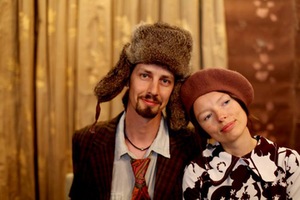Fake realities of Renata Vinckevičiūtė 1
In brief: Works of the Lithuanian textile artist of the young generation Renata Vinckevičiūtė may be recognised easily by touching surfaces – they are made from the material seldom used in art, sandpaper. The artist is a woodworker’s daughter; therefore, it is natural that R. Vinckevičiūtė got acquainted with this material in her early years of childhood. She started using sandpaper during the first year of studies at Vilnius Academy of Arts. The deepest layers of works of R. Vinckevičiūtė hide in this material.
The works of R. Vinckevičiūtė are psychological zones by which she aims to mislead the viewer, his/her seeing and understanding, encourages him/her to doubt the reality of the surrounding world. Visitors of the recent art fair ArtVilnius‘2013 who saw the installation of R. Vinckevičiūtė “Soviet Romanticism” could testify this. In the event the installation was elected the best stand of the fair by the visitors (it was presented by VMU art gallery 101).
In the interview the artist R. Vinckevičiūtė is asked about the impressions from the art fair and her plans regarding the works to be presented at Kaunas Biennial. She reveals the secrets how she managed to work with sandpaper that is not transformed easily, how and what this material says in works of R. Vinckevičiūtė.
The artist remembers that she started using sandpaper in the third year of her studies during the lecture Untraditional Embroidery (lecturer Lina Jonikė). The aim of the subject was to discover untraditional relations between material and traditional embroidery. She started embroidering sandpaper and trying out different materials and factures. The experiments of the artist continue until now.
As for the installation “Soviet Romanticism” the artist states that it is not a romantic look to those times, her attitude is rather ironic. “The aura of the work and its meanings may be understood only inside of the installation. The work may be realised by touching it too,” R. Vinckevičiūtė explains.
“I “translate” the initial function of the object and change it to the contrary, I turn the object into a certain antipode. I aim to mislead the viewer and to place him/her in an interesting and inconvenient situation so that a certain impression of uncertainty appears,” the artist speaks about her art that creates conditions for the viewer to appear in fake reality.
R. Vinckevičiūtė is going to present the newest project “The Abandoned” in the young artists’ programme of Kaunas Biennial in September. The project speaks about the sore social problem of today – emigration and its consequences. The artist states that the idea of this work was born while creating the works “I am Woodworkers’ Daughter”. She spoke about personal experiences but also about the universal problem of relation between the father and daughter. The aim of the project is to turn attention to the problem and to notice children whose parents have emigrated and who have been abandoned in this way. “The generation of wild children with laws of the jungle is growing. I expect to turn attention of people and make then think,” the artist states.
The artist is also asked about the impressions from the international art fair ArtVilnius‘2013, where her installation “Soviet Romanticism” was presented. R. Vinckevičiūtė participated in the event of such format for the first time and it brought much interesting experience. The installation was a big team work. Much energy was put into it by the head of VMU art gallery 101 Daiva Citvarienė, curator of the gallery Ana Čižauskienė and head of VMU art centre Virginija Vitkienė.
Also, the artist Kristina Čyžiūtė contributed to the project much. She organised photo sessions on Saturday and Sunday. The entire team worked hard and the diploma of the best gallery was received from the audience not in vain.


















